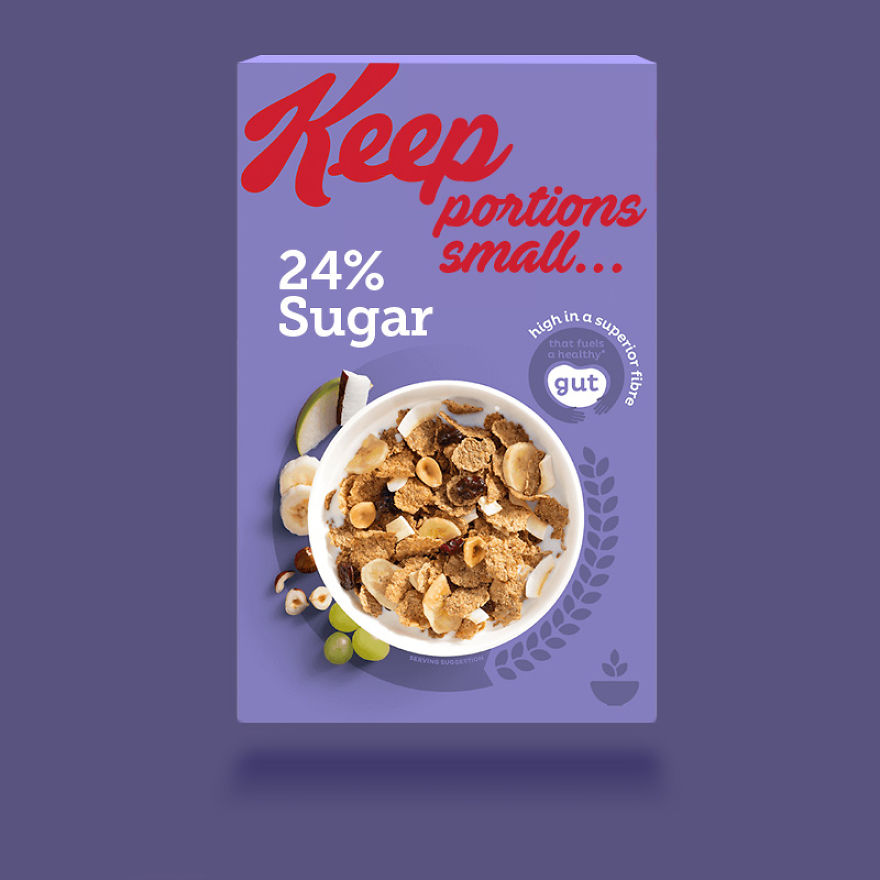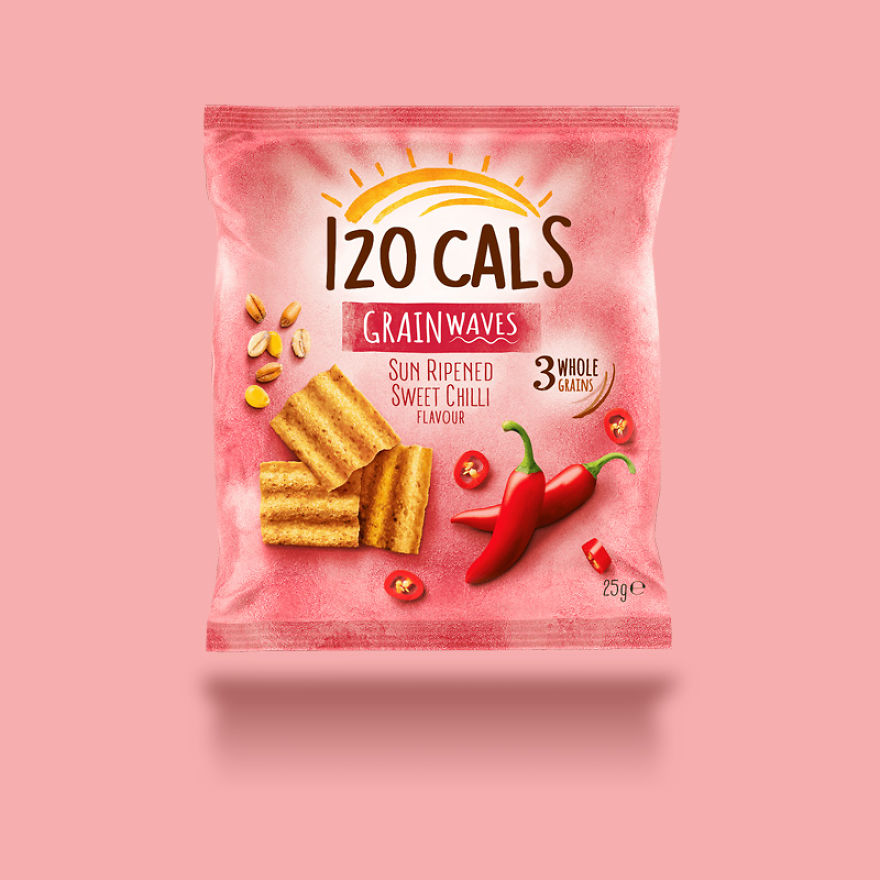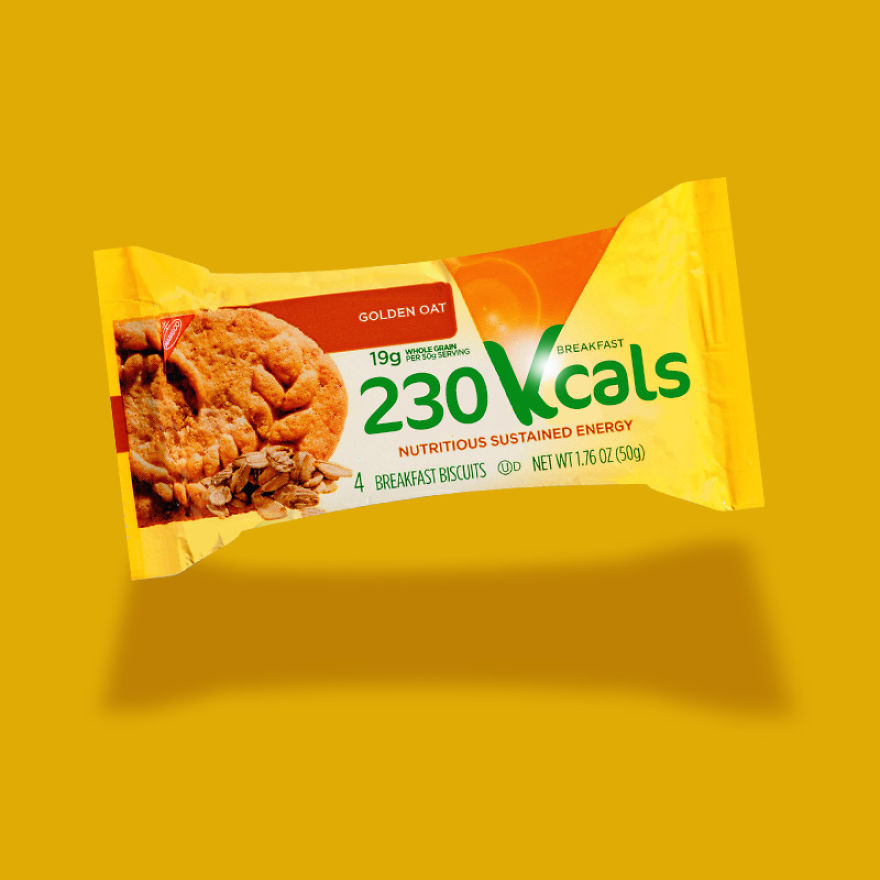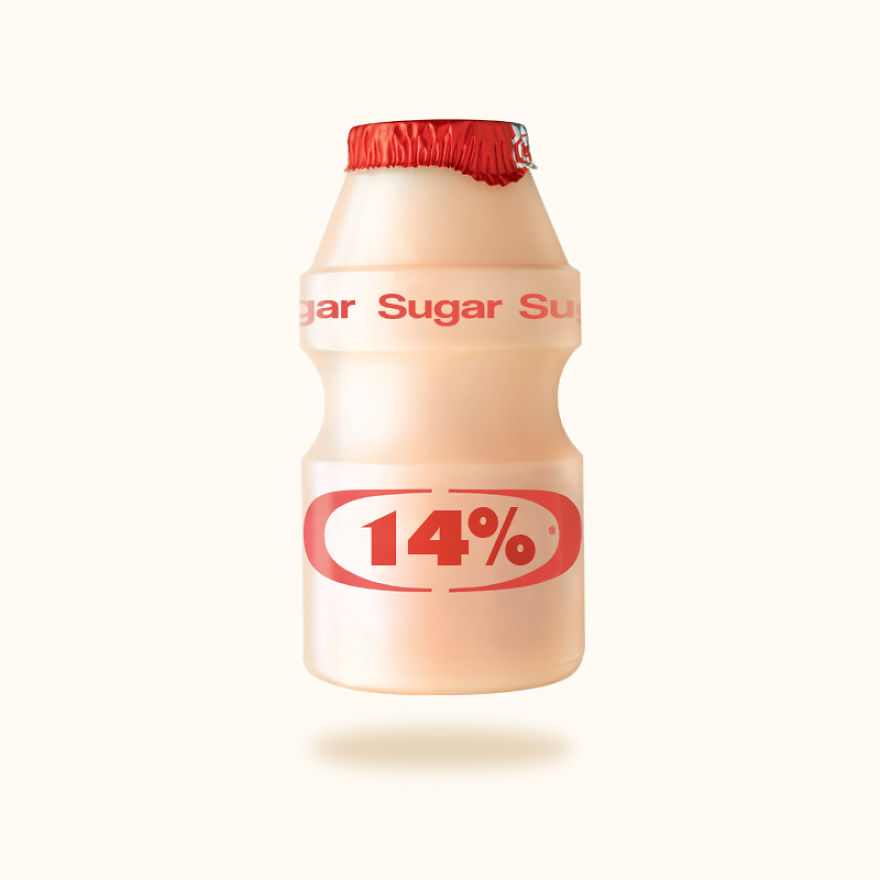Food labeling is a minefield. Bright colors and straplines such as “no added fat” and “high in protein” really draw people in. Marketing campaigns designed to add familiarity to brand name products, means we’re more than comfortable to just grab and go when in need of a snack, all without a second thought. We trust what we’re told and most often remain ignorant to the rest of the nutritional data that’s usually hidden away in the fine print.
It’s law in the UK to include all of the nutritional information on pre-packed food and the Gov.UK website states that “legislation sets requirements for food labels in the UK and aims to ensure food labels are an honest presentation of food. The requirements in place to ensure consistency for the industry and for consumers”. That said, tactical design and a vested interest in ensuring the product is as appealing as possible, means that often these details can quite easily be overlooked.
This got us thinking… if food packaging was “redesigned” to explicitly depict the more alarming details that can be found hidden away in the nutritional information, would we still buy and eat the products in such volume?
So, we’ve taken a selection of well-known products that are specifically marketed as a healthier option and redesigned their labels to represent some of the less desirable traits they hold such as sugar content, which can have a huge impact on our day-to-day health and well being. We have to say, we were quite shocked by some of the findings!
More info: amica-international.co.uk
This post may include affiliate links.
Kellogg's Fruit N' Fibre
One of Kellogg's longest-serving cereals, Fruit ‘n Fibre has been on many breakfast tables over the years. And while it’s marketed as a high-fibre breakfast that helps to keep your digestive system healthy, with a recommended serving size of just 40g, it’s very easy to go overboard when it comes to portion control. Kelloggs state that in each 40g portion, 9.6g of that is sugar, most of which is added… not something you want to overindulge in.
Tropicana Orange Juice
It’s stated that there’s no added sugar in Tropicana orange juice, which is great! However, as oranges are squeezed the natural sugars are released, meaning that one 250ml bottle of juice holds the equivalent of almost five teaspoons of sugar (22g). The recommended serving size of Tropicana Orange Juice is just 150ml, this means that by finishing a 250ml bottle in one sitting, you’re already overindulging. To add a little more perspective, one averaged-sized orange has approximately 8g to 9g of sugar, so a 250ml bottle would be like trying to eat three whole oranges in one go. The only difference being, three oranges would take longer to digest and your body would work harder to process the sugar. Moral of the story… choose the fruit rather than the juice!
Nestlé Milkybar
Ok, so this one isn’t health food, we know, but it is marketed at children and is often considered to be the better choice when giving kids chocolate. But how so, remains a mystery. Yes, white chocolate has a higher milk content and less cocoa, but the sugar and fat levels are as high as ever. A standard 25g bar of Milkybar has a whopping 13.2g of sugar and 7.9g of fat. When compared to a Nestlé Crunch milk chocolate bar of the same weight, both the sugar and fat content are actually higher in a Milkybar (a Crunch bar has 12.6g of sugar and 6.4g of fat).
Bertolli Olive Spread
Ok, so we know you’re not going to eat a whole 25og tub of Bertolli Olive Spread, but when margarine and olive spreads are marketed as a healthy alternative to butter, it’s quite an eye-opening stat. An average recommended portion size is 10g, which in reality is barely enough for one slice of toast. That 10g serving has 59 calories when compared to butter which has on average 74 calories for the same size serving, it begs the question – is it really the healthier option? Add to this the list of additives, emulsifiers, preservatives and the fact that only 21% of the spread is actually made from the delicious Mediterranean olive oil they emphasise so well, it soon loses its appeal.
Müller Light Yogurt
If you love yogurt but you don’t want the high levels of fat and sugar that often come with it, then the promise of 0% fat and no added sugar makes Müller Light extremely appealing. However, that doesn’t mean they’re without a solid dose of sugar. Much like orange juice, many of the variations contain fruit puree, and an average 160g Müller Light contains 10.5g of sugar because of it… that’s the equivalent of 2 teaspoons!
Weetabix Protein On The Go Breakfast Drink
What could be better than your favorite breakfast cereal and lashings of milk all in one easy drink that you can consume on the bus as you trek to work? Add to that the promise of more protein to help keep you fuller for longer and you’re sold. However, what Weetabix don’t shout about is the level of sugar in each 275ml drink. With the equivalent of almost 3 teaspoons full of added sugar, breakfast on the go might not be a great idea after all.
So why does it say 3x teaspoons? 3 times teaspoons? What does that mean?
Walkers Sunbites
If you’re in need of a quick snack, Walkers Sunbites are marketed as a wholesome snack that’s filled with natural flavors. While this might be true, it’s worth pointing out that nutritionally the stats aren’t quite as positive as you might think. With 15.3g of carbs, 5.4g of fat and 120cal per 25g pack, there are definitely healthier snacks out there that pack a less damaging punch.
Belvita Breakfast Biscuits
With delicious golden oats and the promise of nutritious, sustained energy, the idea of eating biscuits for breakfast is a dream come true. But with that dream, reality follows. A single pack of four biscuits weighs in at a hefty 230 calories, roughly the same amount as a standard sized chocolate bar. And while they don’t contain the same levels of sugar as chocolate, they still contain almost two full teaspoons!
If you eat that and only that for breakfast the calories are actually ok.
Yakult Yogurt Drink
A 65ml shot of fermented milk with the strapline “A Little Bottle of Science”, you’d be forgiven for thinking that Yakult will somehow change your life if you add it to your daily routine. And while there is evidence to suggest it can aid digestion, it doesn’t detract from the fact that it also contains a hefty sprinkling of sugar too. In fact, one tiny bottle has a whopping 8.8g of sugar, making up 14% of each serving.
It might have a lot of sugar, but this little bottle do help your daily business in the morning, they also get to choose from four different flavors! Aside from the Original, there’s Orange, Grape, and Green Apple. Other Yakult varieties include Yakult Light, which has less sugar and calories.
Nature Valley Salted Caramel Nut Protein Chewy Bar
Another breakfast product that relies heavily on its protein content as the main focus. In reality, these cereal bars are high in calories, fats and sugars – making it a rather unhealthy choice for breakfast. Each 40g bar contains a huge 12.3g of fat, which is almost 20% of your recommended daily allowance. Add to that a teaspoon full of sugar and the high protein levels pale into insignificance.
Why make the calories the main design point? They have that listed on the front to the left, it's not being hidden.
Danone Activia Yogurt And Granola Pot
A classic example of how the term “low fat” doesn’t necessarily mean it’s good for you. The Danone Activia yogurt range is marketed as a low-fat, gut healthy range of grab and go snacks, the yogurt and granola pots are no exception. However, whilst low in fat, they don’t shout too loudly about the fact there is over 18g of sugar in each 165g pot… that’s almost 4 teaspoons full!
Well... An average woman needs about 2000 kcal of energy a day to keep her body going. Most of that is energy. 2000 kcal in just energy (sugar) would be more than 200 cubes a day. Now I don't want to say we should live on sugar alone, of course fats and protein count for a lot of the calories, but it does give some perspective when people start translating sugar content to cubes. Say you have 6 meals/snacks a day and each would have 4 teaspoons/cubes of sugar in a meal, that would account for 24 teaspoons/cubes. That's 8-9% of the 2000 kcal we need.
Not a very revealing article. All of those "shocking" facts are already on the original packages. They ARE already "marked honestly", there is no need to write the components with larger font or put them on packaging instead of producer's logo. Ok, it is a problem that people so blindly believe that "healthy" products are really "healthy". Nonetheless, I doubt this post really will change anything, especially since it is neither really interesting nor visually attractive.
The problem is..I've seen a lot of packing that boasts "Healthy," "No sugar added," "100% juice" and "Diet." Problem is Healthy = healthier than our normal product, but still not good for you. No sugar added = we still put sugar alcohol in it. 100% juice means = while you think you are buying 100% cranberry juice, we added apple, pear and grape juice which is the equivalent of licking a block of sugar. Diet = we make it seem like you'll lose weight..but we don't tell you that our diet shake has as much sugar as a can of soda.....And it has the same probability of keeping you full. Basically..companies take advantage of peoples laziness by putting big misleading words on the front and telling the truth in small letters in the back.
Load More Replies...So by redesigning the packages for the "truth" they mean just putting a larger print of the amount of calories
Companies are there to make money, not make you healthy. Learn to read labels closely.
Not exactly. Yes, a company's goal is to make money, but they are obligated to accomplish that goal by telling the truth, or they are guilty of false advertising and even fraud. So as long as they don't even allude or imply that the food is healthy (in the way that they advertise), their product can be as unhealthy as possible in order to provide a tastier food. But if they make claims on their ads or their packaging alluding to or implying that the food has health benefits, their goal needs to be a healthy product.
Load More Replies...Not a very revealing article. All of those "shocking" facts are already on the original packages. They ARE already "marked honestly", there is no need to write the components with larger font or put them on packaging instead of producer's logo. Ok, it is a problem that people so blindly believe that "healthy" products are really "healthy". Nonetheless, I doubt this post really will change anything, especially since it is neither really interesting nor visually attractive.
The problem is..I've seen a lot of packing that boasts "Healthy," "No sugar added," "100% juice" and "Diet." Problem is Healthy = healthier than our normal product, but still not good for you. No sugar added = we still put sugar alcohol in it. 100% juice means = while you think you are buying 100% cranberry juice, we added apple, pear and grape juice which is the equivalent of licking a block of sugar. Diet = we make it seem like you'll lose weight..but we don't tell you that our diet shake has as much sugar as a can of soda.....And it has the same probability of keeping you full. Basically..companies take advantage of peoples laziness by putting big misleading words on the front and telling the truth in small letters in the back.
Load More Replies...So by redesigning the packages for the "truth" they mean just putting a larger print of the amount of calories
Companies are there to make money, not make you healthy. Learn to read labels closely.
Not exactly. Yes, a company's goal is to make money, but they are obligated to accomplish that goal by telling the truth, or they are guilty of false advertising and even fraud. So as long as they don't even allude or imply that the food is healthy (in the way that they advertise), their product can be as unhealthy as possible in order to provide a tastier food. But if they make claims on their ads or their packaging alluding to or implying that the food has health benefits, their goal needs to be a healthy product.
Load More Replies...
 Dark Mode
Dark Mode 

 No fees, cancel anytime
No fees, cancel anytime 















































